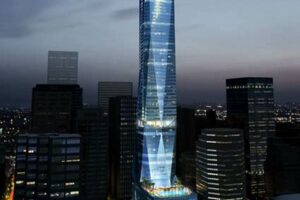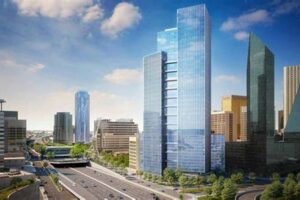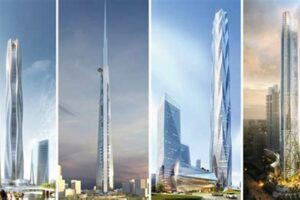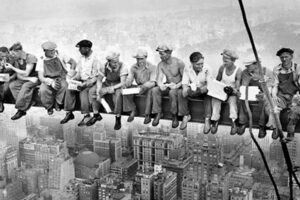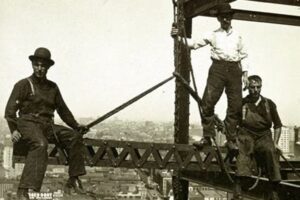The 1920s witnessed a surge in the construction of skyscrapers, which transformed the skylines of major cities around the world. These towering structures played a crucial role in shaping the urban landscapes and economies of the time.
The rapid growth of cities and the increasing demand for office space fueled the construction of these architectural marvels. Skyscrapers provided a solution to accommodate the growing populations while maximizing land usage in densely populated urban centers. They became symbols of economic prosperity and technological advancements, attracting businesses and investment to the cities where they were built.
This article delves into the fascinating history of skyscraper construction in the 1920s, exploring the architectural innovations, engineering challenges, and the profound impact these structures had on urban development and the built environment.
1. Architectural Innovation
Architectural innovation played a vital role in shaping skyscraper construction during the 1920s. Two prominent styles, Art Deco and Gothic Revival, significantly influenced the designs of these towering structures, leaving a lasting legacy on the world’s skylines.
- Art Deco Style: Art Deco, an influential style of the 1920s and 1930s, characterized skyscrapers with geometric forms, sleek lines, and decorative motifs. Notable examples include the Chrysler Building and Empire State Building in New York City.
- Gothic Revival Style: Gothic Revival, inspired by medieval Gothic architecture, incorporated pointed arches, ribbed vaults, and elaborate ornamentation into skyscraper designs. The Woolworth Building in New York City exemplifies this style.
- Combination of Styles: Many skyscrapers combined elements of both Art Deco and Gothic Revival styles, creating unique and visually striking structures. The setback design, a signature feature of the 1920s skyscrapers, was influenced by zoning laws and the desire to maximize natural light and ventilation.
- Iconic Landmarks: The architectural innovation of the 1920s resulted in the creation of iconic landmarks that have become symbols of major cities. These skyscrapers not only served as functional office buildings but also embodied the spirit of progress and modernity.
The fusion of Art Deco and Gothic Revival styles, along with the innovative use of setbacks, transformed the aesthetics of skyscrapers and left an enduring mark on the architectural landscape of the 20th century.
2. Engineering Advancements
The development of steel frames and reinforced concrete during the 1920s revolutionized skyscraper construction. These engineering advancements enabled architects and engineers to design and build structures that reached unprecedented heights and spanned vast distances.
Steel frames provided a lightweight and incredibly strong skeletal structure for skyscrapers. These frames, made of iron or steel beams and columns, allowed for the construction of buildings that were both tall and slender. Reinforced concrete, a composite material made of concrete reinforced with steel rods or mesh, provided additional strength and durability, enabling the construction of floors and walls that could withstand the immense weight and forces acting on high-rise structures.
The combination of steel frames and reinforced concrete allowed architects to push the boundaries of design and create skyscrapers that soared above anything previously constructed. The Chrysler Building in New York City, completed in 1930, exemplified these advancements, reaching a height of 1,046 feet with its iconic Art Deco spire. The Empire State Building, completed in 1931, surpassed the Chrysler Building as the world’s tallest building at 1,250 feet, showcasing the remarkable capabilities of steel frame construction.
Understanding the connection between engineering advancements and skyscraper construction is crucial for appreciating the architectural achievements of the 1920s. Steel frames and reinforced concrete were not merely components but fundamental enablers of the iconic skyscrapers that transformed skylines and continue to shape our cities today.
3. Technological Progress
Technological progress played a pivotal role in the development of skyscrapers during the 1920s. Three key advancementselevators, electrical systems, and plumbingwere instrumental in making high-rise living and working not only feasible but also desirable.
- Elevators: Before the invention of elevators, buildings were limited to a few stories as climbing stairs became impractical beyond certain heights. The development of electric elevators in the 19th century made it possible to transport people and goods efficiently to upper floors, paving the way for the construction of taller buildings.
- Electrical systems: The widespread availability of electricity in the early 20th century revolutionized skyscraper construction. Electrical systems provided power for lighting, elevators, and other essential building services, enabling high-rise structures to function effectively.
- Plumbing: Adequate plumbing systems were crucial for sanitation and hygiene in high-rise buildings. The development of efficient plumbing fixtures and drainage systems made it possible to provide running water and proper waste disposal for multiple floors, ensuring the health and well-being of occupants.
The convergence of these technological advancements allowed architects and engineers to design and construct skyscrapers that were not only tall but also comfortable and livable. These buildings transformed the urban landscape, providing much-needed office space and residential units in densely populated cities.
4. Economic Boom
The economic boom following World War I played a critical role in the surge of skyscraper construction during the 1920s. The war had stimulated industrial production and technological advancements, leading to increased wealth and investment opportunities.
- Increased demand for office space: The post-war economic expansion led to a growing number of businesses and corporations, resulting in a high demand for office space in major cities. Skyscrapers provided a solution by offering large floor plates and centralized locations, catering to the needs of these businesses.
- Residential: The urban population also experienced growth during this period, driven by factors such as migration from rural areas and the expansion of industries. This increased demand for housing led to the construction of residential skyscrapers, providing more living space in densely populated cities.
- Investment opportunities: The economic prosperity of the 1920s made real estate development and skyscraper construction an attractive investment opportunity. Investors saw the potential for high returns and were willing to finance these projects, contributing to the boom in skyscraper construction.
- Civic pride and competition: The construction of skyscrapers also became a matter of civic pride and competition among cities. Cities vied to build the tallest and most impressive skyscrapers, which were seen as symbols of progress and economic vitality.
The economic boom of the 1920s was a significant driving force behind the construction of skyscrapers. The increased demand for office and residential space, coupled with the availability of investment capital, fueled the development of these iconic structures that transformed urban skylines.
5. Urbanization
The urbanization of the 1920s played a crucial role in the proliferation of skyscraper construction. As cities grew rapidly, the demand for housing and commercial space intensified, leading to a need for innovative solutions to accommodate the increasing population.
Skyscrapers emerged as a practical answer to the challenges posed by urbanization. By building vertically, cities could maximize land usage, reduce urban sprawl, and provide much-needed space for businesses, offices, and residents. This upward expansion not only addressed the immediate space constraints but also allowed for better city planning and infrastructure development.
Real-life examples abound. In New York City, the construction of skyscrapers transformed the Manhattan skyline and accommodated the city’s burgeoning population. The Chrysler Building and the Empire State Building, both completed in 1930, became iconic symbols of the era’s architectural achievements and the response to urbanization.
Understanding the connection between urbanization and skyscraper construction is essential for grasping the historical context and significance of these architectural marvels. Skyscrapers were not merely feats of engineering but also practical solutions to the challenges posed by rapid urbanization and population growth. By providing vertical living spaces and commercial centers, skyscrapers played a vital role in shaping the urban landscapes of the 20th century.
6. Land Scarcity
In the 1920s, major cities worldwide experienced a surge in population and economic growth. This rapid urbanization led to a scarcity of land, especially in densely populated urban areas. As a result, architects and city planners turned to vertical construction as a solution to accommodate the growing population and businesses.
Skyscrapers emerged as a practical response to land scarcity. By building upwards, cities could maximize land usage and minimize urban sprawl. This upward growth not only addressed the immediate space constraints but also allowed for better city planning and infrastructure development. For example, the construction of skyscrapers in New York City’s Manhattan allowed the city to accommodate its growing population without expanding its geographical footprint.
Understanding the connection between land scarcity and skyscraper construction is essential for grasping the historical context and significance of these architectural marvels. Skyscrapers were not merely feats of engineering but also practical solutions to the challenges posed by rapid urbanization and population growth. By providing vertical living spaces and commercial centers, skyscrapers played a vital role in shaping the urban landscapes of the 20th century.
7. Symbol of Progress
Skyscrapers, during the 1920s, were more than just architectural marvels; they were symbols of economic and technological achievements that boosted civic pride. The construction of skyscrapers was closely intertwined with the notion of progress and modernity, reflecting the optimism and ambition of the era.
The ability to construct towering structures that reached new heights was seen as a testament to human ingenuity and engineering prowess. Skyscrapers became symbols of a city’s economic strength and technological advancement. The completion of iconic buildings like the Chrysler Building and the Empire State Building in New York City drew national and international attention, solidifying the city’s position as a global economic and cultural hub.
Beyond their economic and technological significance, skyscrapers also played a vital role in shaping civic identity. They became landmarks that instilled a sense of pride and belonging among the city’s residents. The construction of skyscrapers was often accompanied by public celebrations and competitions, reflecting the communal excitement and enthusiasm surrounding these architectural achievements.
The connection between skyscrapers and civic pride extended beyond individual cities. Skyscrapers became symbols of national progress and economic growth. They were featured on postcards, travel posters, and other promotional materials, showcasing the nation’s architectural prowess and economic strength to the world.
Understanding this connection between skyscrapers and civic pride is essential for appreciating the cultural and historical significance of these structures. Skyscrapers were not merely functional buildings; they were tangible expressions of a city’s aspirations and a source of pride for its residents.
8. Cultural Impact
The cultural impact of skyscraper construction in the 1920s extended beyond the physical realm, deeply influencing the world of art and literature. The towering structures sparked the imagination of creatives, inspiring artistic expression and literary narratives that captured the fascination with these architectural wonders.
Art deco, a prominent artistic style of the period, drew inspiration from the sleek lines and geometric forms of skyscrapers. Artists such as Georgia O’Keeffe and Charles Sheeler incorporated these architectural elements into their paintings, capturing the essence of the urban landscape and its towering structures. Literature also embraced this fascination, with authors like F. Scott Fitzgerald and John Dos Passos using skyscrapers as symbols of ambition, progress, and the changing social landscape.
The practical significance of understanding this connection lies in its ability to provide a richer appreciation of the cultural context surrounding skyscraper construction in the 1920s. By examining the artistic and literary reflections of this architectural phenomenon, we gain insights into the broader cultural values, aspirations, and anxieties of the era. This understanding enhances our appreciation of skyscrapers not only as architectural achievements but also as cultural artifacts that mirror the zeitgeist of their time.
FAQs on Skyscraper Construction in the 1920s
This section addresses frequently asked questions about the construction of skyscrapers during the 1920s, providing concise and informative answers to enhance your understanding of this significant period in architectural history.
Question 1: What factors contributed to the surge in skyscraper construction during the 1920s?
The 1920s witnessed a convergence of factors that fueled the construction of skyscrapers. These included rapid urbanization, land scarcity in major cities, technological advancements in steel frame construction and elevator systems, and a booming economy that provided the necessary capital for these ambitious projects.
Question 2: How did technological advancements impact skyscraper construction?
Technological advancements played a pivotal role in enabling the construction of taller and more sophisticated skyscrapers. The development of steel frames provided a lightweight and sturdy structural framework, while the invention of electric elevators made it feasible to transport people and materials efficiently to higher floors. These innovations pushed the boundaries of architectural design and engineering capabilities.
Question 3: What architectural styles influenced the design of skyscrapers in the 1920s?
Skyscrapers built in the 1920s showcased a variety of architectural styles, with Art Deco and Gothic Revival being particularly prominent. Art Deco, characterized by geometric forms and sleek lines, added a touch of modernity to these towering structures. Gothic Revival, inspired by medieval architecture, incorporated elements such as pointed arches and ribbed vaults, lending a sense of grandeur and historical reverence.
Question 4: How did skyscrapers impact the urban landscape and city life?
Skyscrapers transformed the urban landscape, creating dense vertical communities and reshaping city skylines. They provided much-needed office space for businesses, accommodated a growing population, and became symbols of economic prosperity and architectural achievement. The concentration of people and activities in these high-rise structures also influenced urban planning and the development of infrastructure and transportation systems.
Question 5: What are some notable examples of skyscrapers constructed in the 1920s?
The Chrysler Building and the Empire State Building in New York City stand as iconic examples of skyscraper construction in the 1920s. The Chrysler Building, completed in 1930, was the tallest building in the world at the time and featured a distinctive Art Deco design. The Empire State Building, completed in 1931, surpassed the Chrysler Building in height and became an enduring symbol of New York City and American architecture.
Question 6: What legacy did the skyscraper construction of the 1920s leave on architecture and urban development?
The skyscraper construction boom of the 1920s left a lasting legacy on architecture and urban development. It demonstrated the potential of steel frame construction and elevator technology, paving the way for even taller and more innovative skyscrapers in the future. The architectural styles and design principles developed during this period continue to influence contemporary skyscraper design, and the concept of vertical urban living remains a defining feature of modern cities worldwide.
These frequently asked questions provide key insights into the factors, innovations, and cultural significance of skyscraper construction in the 1920s. Understanding these aspects enhances our appreciation for the architectural achievements of this period and their enduring impact on the built environment.
Transition to the next article section:
By exploring the historical context, engineering marvels, and cultural influences surrounding skyscraper construction in the 1920s, we gain a deeper understanding of the transformative role these architectural wonders played in shaping modern cities and architectural practices.
Tips for Understanding Skyscraper Construction in the 1920s
To delve deeper into the subject of skyscraper construction during the 1920s, consider these informative tips:
Tip 1: Explore Historical Context
Grasp the historical context of the 1920s, including the economic boom, rapid urbanization, and technological advancements that fueled the construction of skyscrapers.
Tip 2: Examine Engineering Innovations
Understand the groundbreaking engineering techniques used in skyscraper construction, such as steel frame construction and the development of efficient elevator systems, which enabled the creation of taller and more stable structures.
Tip 3: Analyze Architectural Styles
Study the architectural styles that influenced skyscraper design during the 1920s, particularly Art Deco and Gothic Revival, which added unique aesthetic elements and influenced the overall appearance of these buildings.
Tip 4: Consider Urban Impact
Examine the impact of skyscraper construction on urban landscapes and city life, including the concentration of businesses and population in vertical spaces, as well as the challenges and opportunities it presented for urban planning and infrastructure development.
Tip 5: Explore Cultural Significance
Understand the cultural significance of skyscrapers in the 1920s, as they became symbols of economic prosperity, technological prowess, and the aspirations of the era, which was reflected in art, literature, and popular culture.
Tip 6: Visit Landmark Buildings
If possible, visit iconic skyscraper landmarks from the 1920s, such as the Chrysler Building or the Empire State Building, to gain a firsthand appreciation of their architectural grandeur and historical importance.
Tip 7: Read Historical Accounts
Consult historical accounts, books, and articles to gain a deeper understanding of the challenges, triumphs, and controversies surrounding skyscraper construction during the 1920s.
Tip 8: Engage with Experts
Engage with experts in architecture, history, or urban planning to gain specialized knowledge and insights into the topic of skyscraper construction in the 1920s.
By following these tips, you can develop a comprehensive understanding of skyscraper construction in the 1920s, its historical context, engineering innovations, architectural styles, urban impact, cultural significance, and lasting legacy.
Transition to the article’s conclusion:
Through a deeper exploration of these aspects, we can appreciate the ingenuity, ambition, and transformative power that characterized skyscraper construction in the 1920s, an era that forever changed the skylines and urban landscapes of the world.
Conclusion
The exploration of skyscraper construction in the 1920s reveals a fascinating chapter in architectural history marked by innovation, ambition, and urban transformation. The convergence of economic prosperity, technological advancements, and architectural ingenuity led to the creation of iconic structures that redefined skylines and reshaped city life.
Skyscrapers became symbols of economic power, engineering prowess, and cultural aspirations. Their construction showcased the potential of steel frames, elevators, and new architectural styles like Art Deco and Gothic Revival. These structures not only provided much-needed office and residential space but also shaped the urban fabric and influenced urban planning.
As we reflect on the legacy of skyscraper construction in the 1920s, we recognize the enduring significance of these architectural marvels. They stand as testaments to human ingenuity, the pursuit of progress, and the ever-evolving relationship between cities and their built environment. Their impact continues to inspire and inform contemporary architecture and urban design, reminding us of the transformative power of vertical living and the timeless allure of reaching for the skies.


